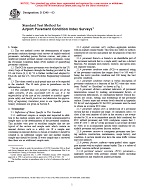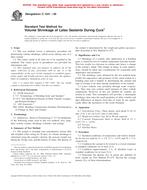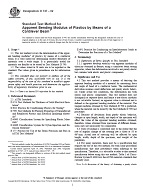Click here to purchase
p>1.1 This practice describes procedures for determining the amount and angular distribution of optical scatter from a surface. In particular it focuses on measurement of the bidirectional scattering distribution function (BSDF). BSDF is a convenient and well accepted means of expressing optical scatter levels for many purposes. It is often referred to as the bidirectional reflectance distribution function (BRDF) when considering reflective scatter or the bidirectional transmittance distribution function (BTDF) when considering transmissive scatter.
1.2 The BSDF is a fundamental description of the appearance of a sample, and many other appearance attributes (such as gloss, haze, and color) can be represented in terms of integrals of the BSDF over specific geometric and spectral conditions.
1.3 This practice also presents alternative ways of presenting angle-resolved optical scatter results, including directional reflectance factor, directional transmittance factor, and differential scattering function.
1.4 This practice applies to BSDF measurements on opaque, translucent, or transparent samples.
1.5 The wavelengths for which this practice applies include the ultraviolet, visible, and infrared regions. Difficulty in obtaining appropriate sources, detectors, and low scatter optics complicates its practical application at wavelengths less than about 0.2 m (200 nm). Diffraction effects start to become important for wavelengths greater than 15 m (15 000 nm), which complicate its practical application at longer wavelengths. Measurements pertaining to visual appearance are restricted to the visible wavelength region.
1.6 This practice does not apply to materials exhibiting significant fluorescence.
1.7 This practice applies to flat or curved samples of arbitrary shape. However, only a flat sample is addressed in the discussion and examples. It is the users responsibility to define an appropriate sample coordinate system to specify the measurement location on the sample surface and appropriate beam properties for samples that are not flat.
1.8 This practice does not provide a method for ascribing the measured BSDF to any scattering mechanism or source.
1.9 This practice does not provide a method to extrapolate data from one wavelength, scattering geometry, sample location, or polarization to any other wavelength, scattering geometry, sample location, or polarization. The user must make measurements at the wavelengths, scattering geometries, sample locations, and polarizations that are of interest to his or her application.
1.10 Any parameter can be varied in a measurement sequence. Parameters that remain constant during a measurement sequence are reported as either header information in the tabulated data set or in an associated document.
1.11 The apparatus and measurement procedure are generic, so that specific instruments are neither excluded nor implied in the use of this practice.
1.12 For measurements performed for the semiconductor industry, the operator should consult Practice SEMI ME 1392.
This standard does not purport to address all of the safety concerns, if any, associated with its use. It is the responsibility of the user of this standard to establish appropriate safety and health practices and determine the applicability of regulatory limitations prior to use.
Product Details
- Published:
- 01/01/2005
- Number of Pages:
- 14
- File Size:
- 1 file , 210 KB


